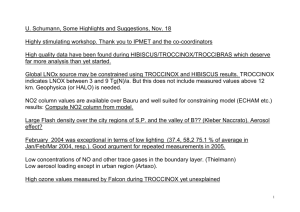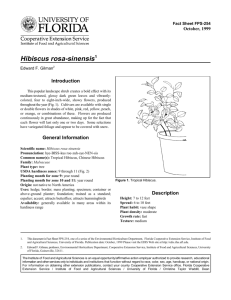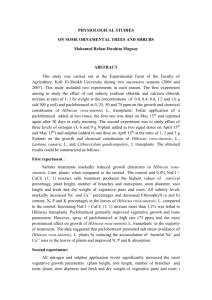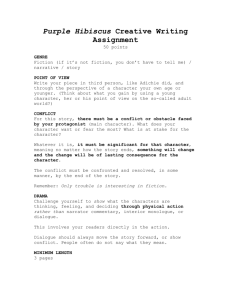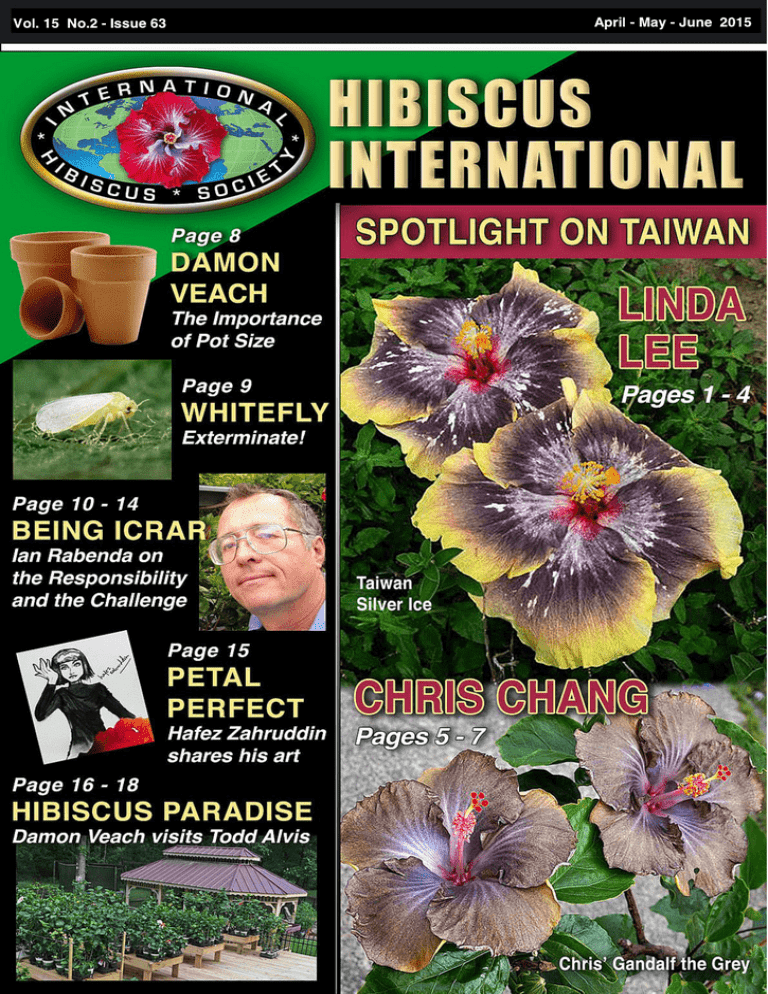
Vol. 1 5 No.2 - Issue 63
HIBISCUS INTERNATIONAL
April - May - June 201 5
SPOTLIGHT ON TAIWAN!
Linda Lee ­ 411 registered hybrids
Aerial view of Kaohsiung and the Love River.
L
inda Lee lives in the south­east of Taiwan,
in Kaohsiung, which is the 2nd largest city
on the island. It is also said to be the sunniest
area of Taiwan. Linda started growing tropical
Hibiscus in 2009 and grows them in the
ground.
Located over a degree to the south of the
Tropic of Cancer, Kaohsiung enjoys a tropical
savanna climate. Although classified as
tropical, the city does have a defined cooler
season between December to March when
daily temperatures average about 25ºC
(77°F), with the occasional cold front. Daily
temperatures the rest of the year average
about 30ºC (86°F). There is a monsoon
season, primarily from June to August, and
average annual rainfall is about 74 inches.
TAIWAN DREAM FLYING
(Tahitian Fleuro Star x Mr Ace)
HIBISCUS INTERNATIONAL
1
TAIWAN BRIDE OF SATAN
TAIWAN DARK KING
(Yoda x Allure)
(Dreamscape x Barry Schlueter)
TAIWAN DARK QUEEN
(Not registered)
TAIWAN PURPLE MAGICAL
FAIRY
(Lazurite x Persian Rug)
TAIWAN PURPLE SPOTTED
BUTTERFLY
(Unknown x Unknown)
TAIWAN VOLCANO CAP
(Mr Ace x Taiwan Moonlight Bird)
HIBISCUS INTERNATIONAL
2
TAIWAN GOLD DIGGER
TAIWAN ICE FANTASIES
(Not registered)
(Not registered)
TAIWAN UNICORN
(Not registered)
TAIWAN SILVER ICE
(Not registered)
TAIWAN SILVER FEATHER
(Not registered)
TAIWAN MAGIC STAR
(Wallflower x City Slicker)
TAIWAN KING ARTHUR
(Not registered)
TAIWAN TREBLE CLEF
(Not registered)
HIBISCUS INTERNATIONAL
3
Linda Lee has her own website at http://www.prettilife.com/hibiscus/ where she sells both seed and
wood. I have bought seeds from Linda myself and was very pleased with the germination results. I am
very much looking forward to my first Linda Lee blooms in 2016!
TAIWAN MAMBO RIVERSIDE
(Night Runner x Mademoiselle Remy)
HIBISCUS INTERNATIONAL
4
More magic from Taiwan!
Chris Chang
Fengjia Night Market,
Taichung
Chris' Prom Queen
(not registered)
C
hris Chang lives in Taichung, the 3rd largest
city in Taiwan which is situated on the west­
central coast of the island. The climate borders
on being tropical monsoon with an average
annual temperature of 23.3 °C (73.9 °F). The
average annual rainfall is just above 67 inches
and the average humidity is 80%. Occasional
Typhoons emerging from the South China Sea
can pose a threat to the area.
Chris loves all things tropical ­ sun, sea, beaches
in the Philippines and, of course, growing
tropical Hibiscus. Most of his Hibiscus are not
registered yet, but certainly deserve to be!
A gorgeous display of
Chris Chang's blooms
HIBISCUS INTERNATIONAL
5
CHRIS' HALLOWEEN
CHRIS' ENDLESS PASSION
(Persian Rug x My Little Monster)
(Not registered)
CHRIS' PARAGON
CHRIS' SILVER RUNWAY
CHRIS' SOLAR ECLIPSE
(Not registered)
(Not registered)
(Not registered)
LILLIAN'S COSMOPOLITAN
(Not registered)
HIBISCUS INTERNATIONAL
6
CHRIS' TIMELESS
CHRIS' A THOUSAND KISSES
(Not registered)
(Not registered)
CHRIS' BIG ANGEL
(Not registered)
CHRIS' LITTLE OSCAR
(Not registered)
CHRIS' METALLIC GLASS
(Not registered)
CHRIS' SECRET WISHES
(Not registered)
HIBISCUS INTERNATIONAL
7
THE I M P O R TA N C E O F
PO T S I Z E!
D A M O N V E A C H o f f e rs s o m e g o o d a d v i c e
I
do want to stress pot size again. This is very
important to the longevity and health of your plants.
For consistent production of hibiscus flowers, check
those roots and if needed move up a size to allow the
roots to expand. You do not want to transplant your
hibiscus in too deep a container. If you do, your plant
may remain healthy but will spend more energy
producing roots than flowers and top growth.
Therefore you may see fewer flowers until the roots
have hit the bottom of the pot. You also run that
chance of water retention and root rot problems.
If you should want to put more than one plant in a pot,
this mixed planting needs proper balance too. You will
need to use a larger pot, but look for one that is wider
than the nursery pot but not much deeper.
Damon, with his Louisianna garden
full of Hibiscus, is a well known
personality in both the IHS and the
American Hibiscus Society.
A lot of what you do becomes experimental, but your
goal is to keep your plants healthy and producing
plenty of blooms.
POT SIZE CONVERSION
Some people talk in gallons, some in inches
and yet others in centimetres. Here is a handy
conversion guide for pot sizes (approximate).
10cm pot = 4" pot= pint (0.5 quart) = 0.5L
13­15cm pot = 5­6" pot = quart (0.25 gal) = 1L
18­20cm pot = 7­8" pot= 1 gal = 4L
22cm pot = 8.5" pot = 2 gal = 7.5L
25cm pot = 10" pot = 3 gal = 11L
30cm pot = 12" pot = 5 gal = 19L
36cm pot = 14" pot= 7 gal = 26L
41cm pot = 16" pot= 10 gal = 38L
46cm pot = 18" pot = 15 gal = 57L
61cm pot = 24" pot = 25 gal = 95L
76cm pot = 30" pot= 30 gal = 114L
HIBISCUS INTERNATIONAL
8
W HI TE F L Y
G l a s s h o u s e w h i t e f l y ­ T ri a l e u ro d e s v a p o ra ri o ru m
This sap­sucking insect pest breeds rapidly in warm
greenhouse conditions. The adults and their scale­like
nymphs live on the underside of the leaves where they
feed on sap, weakening the plants.
Each female can lay more than 200 eggs which hatch
into small, scale­like nymphs. The length of the life
cycle varies according to the temperature. At 10ºC
(50ºF) the life cycle takes several months, but can be
completed in about three weeks at 21ºC (70ºF). The
pest can remain active during the winter in an
unheated greenhouse, provided suitable host plants
are present. Glasshouse whitefly does not usually
survive winter out of doors.
These pests are now resistant to many insecticides
so you have to attack the problem in different ways.
Whitefly can’t resist the colour yellow, so get some
yellow sticky traps and place them near your plants.
You can also knock the population down a bit by
getting someone to disturb the leaves while you
suck the flying hordes into a vacuum cleaner.
There are a couple of natural parasites available for
indoor control ­ a specialized ladybug and a tiny
parasitic wasp, Encarsia formosa.
Winged adult and nymph.
Products containing the following chemical
ingredients all help with whitefly control ­
Pyrethrum, Natural Fatty Acids and Surfactant
based products.
A HOME MADE CONTROL SPRAY
Add one tablespoon of liquid dishwashing soap
(the regular kind ­ NOT an anti­microbial one) to
a cup of vegetable oil (corn, sunflower etc) and
shake well. THIS MUST BE DILUTED! Mix two
tablespoons of this 'master solution' into a cup of
water, shake well and spray on those infested
undersides.
HIBISCUS INTERNATIONAL
9
I CRA
I n t e rn a t i o n a l C u l t i v a t i o n R e g i s t ra t i o n A u t h o ri t y
The purpose of an ICRA (International Cultivar
Registration Authority) is to maintain an order in
the naming of hybrid cultivars. This means
avoiding confusion by avoiding the duplication of
names as well as avoiding a whole host of other
potential problems with hybrid names such as, for
example, excessively long names. The
International Society for Horticultural Science
appoints and monitors all ICRAs and the ICRA
institution is now an international standard for
keeping order in cultivar names.
Currently, the International Hibiscus Society is the
nominated ICRA for Hibiscus, and Ian Rabenda is
the formally appointed Registrar.
THE
INTERNATIONAL
HIBISCUS SOCIETY
How it all Began
It was Richard Johnson, who lives in remote Tahiti, who
turned his dream of an international Hibiscus community
into reality by laying the foundations of both the
International Hibiscus Society (IHS) and its website.
Richard and Chantelle Johnson
Several IHS members later assisted with the IHS
website but it was Joseph Dimino who spent untold
hours of work developing the online database. Initially
called "The Global Hibiscus Library", or TGHL, its many
features included an online new cultivar registration
system.
It was this groundwork that has enabled the IHS to cope
with a database currently listing over 18,000
international Hibiscus cultivars.
HIBISCUS INTERNATIONAL
Joseph Dimino, sadly missed
10
I CRAR
M y w o rk a s t h e H i b i s c u s R e g i s t a r
B y I an R ab en d a
A
s far as my own personal history is
concerned even members close to
me probably don’t realize that I had a
passion for nomenclature issues even
before I became involved with Hibiscus.
Prior to being bitten by the Hibiscus bug I
was deeply involved in cactus and
succulent plants. At the local cactus club I
was the only member who was deep into
the International Code of Botanical
Nomenclature and the controversy
around the classification of cactus plants.
The subject was the primary focus of my
cactus collection.
A recent entry from the online nomenclature database maintained by the International Hibiscus Society.
HIBISCUS INTERNATIONAL
11
What hibiscus people are probably more
aware of is that I got involved with the
Hibiscus nomenclature on the strength of my
experience programming websites, not
because of my knowledge about nomenclature,
and because Joseph Dimino became too ill
to continue as webmaster.
The IHS as ICRA ­
A Responsibility and a Challenge
The IHS was not the first Hibiscus society to
attempt the maintenance of a Hibiscus
nomenclature. The American Hibiscus
Society made the nomenclature one of its
prime purposes since that society's creation
around 1956. Later, when the ICRA framework
became established as the international
standard for managing the nomenclatures of
cultivated hybrid plants, the Australian
Hibiscus Society became the first Hibiscus
ICRA in 1980. The IHS did not assume the
ICRA designation until relatively recently in
2013. In each case new work was built on
the efforts of those who came before. In
each case also the rapid growth in the size
of the database has made its management
increasingly difficult and challenging.
Holding the ICRA consumes a lot of
resources because it is such a lot of work.
The advent of the internet doubled the
complexity of the undertaking by adding the
complexity of internet technology to making
the data conveniently available online.
Going into the future a good nomenclature
will depend heavily on the availability of
dedicated hard working volunteers, on
the voluntary cooperation of all Hibiscus
hybridizers in registering their hybrids,
and on the financing of expensive
website programming. The IHS is
currently short in all of these departments
and any assistance or participation from
interested parties would be welcome. The
challenge is great but the objective is
worthy.
The IHS Hibiscus database can be searched alphabetically at:
http://www.internationalhibiscussociety.org/SEArchive/A/cvindex1.php
HIBISCUS INTERNATIONAL
12
Current main ICRA duties
1) Processing/analyzing names of newly submitted cultivars for registration on a regular basis.
Requires a thorough understanding of complex ICRA rules. Done by: Ian Rabenda, ICRAR.
2) Transferring data of newly submitted cultivars for registration from the entry form to the
online database. This is currently being done by Kes Winwood and takes a few hours every
day depending on how many are submitted. No matter how automated we try to make the
process it is unavoidably necessary to have some clerical work done scanning recently
submitted applications for registration in order to correct any errors. This is largely now being
done by Kes and myself.
3) Compiling a list of nonregistered cultivars in circulation. This was essentially being done by
Carlos Fernandez, Tanya Capito, and myself. Tanya was scanning through thousands of pages
of old journals and other documents looking for names not yet included in the database. There
is a huge volume of work that still needs to be done in this department.
4) Finding and correcting errors in existing data. This was being done largely by Carlos Fernandez.
The archives show that Carlos probably found thousands of errors in the old data that was inherited.
Carlos was mostly finding the errors and making us aware of them while both Kes and I were making
the actual corrections. Carlos introduced the team to the Oracle Workbench software which both Kes
and I have found extremely useful. It has raised the level of all of our work. Carlos was a whiz at
hibiscus nomenclature but recently retired from this volunteer work. He's going to be greatly missed!!!
5) Reprogramming and maintaining code for database pages on the internet. This has mostly
been done by Kes and myself with some assistance from paid professional programmers.
6) Compiling, printing and mailing a hard copy of the new cultivars registered document for the
International Society for Horticultural Science. This has so far been done by Kes Winwood.
HIBISCUS INTERNATIONAL
13
W HE N A N D W HY
Y O U S HO U L D R E G I S TE R Y O U R P L A N T
When a new seedling has bloomed
and has been evaluated for its merits.
When it has been deemed to be
worthy of keeping and has been
propagated, the new hybrid can be
considered a new cultivar and should
be registered with the ICRA.
It should be registered to ensure, first
and foremost, that the new name
meets the requirements which would
make it a good name useable by the
entire Hibiscus community. Also so
that it can be added to the database
where all Hibiscus enthusiasts have
access to the information associated
with the new cultivar.
WE NEED YOUR PARTICIPATION!
The database is only as good as the
involvement of the entire Hibiscus
community in making it complete. Please
register your new hybrids with us and
check first if your new hybrid name is OK.
If you know of any well known old hybrids
not listed in our database or any other
missing data let us know so that we can
make it more complete. If you would like
to get involved as a volunteer in
maintaining the database just let us know!
You can do a more detailed search for specifics such as colour group at:
http://www.internationalhibiscussociety.org/SEArchive/SEindex1.php
HIBISCUS INTERNATIONAL
14
P E TA L P E R F E C T
HA F E Z Z A HR U D D I N S HA R E S HI S S K E TC H B O O K
Hafez, who teaches English in Kuala
Lumpur, Malaysia treated us to some
wonderful, wacky sketches inspired by
Hibiscus petals. We think they are
TERRIFIC! Thank you Hafez!
HIBISCUS INTERNATIONAL
15
TO D D A L V I S C R E A TE S
A HI B I S C U S P A R A D I S E
A N D D A M O N V E A C H W A S THE R E TO TE L L U S A L L A B O U T I T
Dear Diary ...
It's early coffee time today. I'm sure I will find myself sitting in my back garden for
another cup later this morning, but my front garden has so many of my prized
plants located there now that it will make my front porch much more inviting for an
afternoon glass of wine. I thought I would share a few pictures with you from the
Alvis place in Hammond, Louisianna.
I wanted to show you Todd's handiwork with his elevated Hibiscus patio. Looking
from the greenhouse toward the main house, I really didn't realize that the platform
containing all the Hibiscus plants was actually built as an elevated extension of the
gazebo. There was a low area here so instead of bringing in a load of dirt to level
out and keep water from standing in the yard, Todd decided to build an elevated
Hibiscus patio that connects to the gazebo and house.
A partial view of the Hibiscus deck with complete
sections full of seedlings.
HIBISCUS INTERNATIONAL
16
Views of the Hibiscus deck with the greenhouse in the background (above)
and the gazebo (below).
HIBISCUS INTERNATIONAL
17
All I can tell you is that this is
the most amazing patio I've
ever seen. I have no idea how
many Hibiscus will eventually
end up here, but knowing our
weather conditions in the
winter months I have to
believe that some kind of
cover will go over this or
another big greenhouse will be
added to hold all these plants
when the temperatures drop.
Even this elevated patio is on two
levels with three different steps for
entrance from the yard, patio, and
enclosed lower patio where the
swimming pool is located. I should
have taken more pictures, but you
would almost need a video to get
actually acquainted with this really
amazing display area. Referring to it
as a deck does not do this structure
justice. It is definitely an elevated
(multi­level) Hibiscus patio with
supports anchored in concrete.
I am sure we would all like to
say a big 'THANK YOU' to
Damon for photographing and
sharing Todd's amazing work!
What a labour of love! Most of
us can only dream of such a
perfect Hibiscus paradise!
Todd Alvis (left) and Danny pose for a
quick photo during their work on the
amazing deck.
HIBISCUS INTERNATIONAL
18
HOT TIPS!
AVOID FERTILIZER BURN
by Diego Dominguez
When you fertilize be careful not to apply the same dose to both mature and immature
plants. If you do, the results might be similar to the ones shown here!
TREASURE THAT WOOD!
Photo by Edwin Guzman
by Gail Cahi
HIBISCUS INTERNATIONAL
Prepare all of your cuttings for rooting and then let
them soak in a bath of water for +/­ 12 hours to
make certain that they have fully rehydrated before
using the rooting hormone and planting. If you are
using a liquid rooting hormone, let them stand in it
for 30 minutes before planting, don't just dip them in
as the instructions say.
I got this tip from a top Camellia horticulturist and it
works. I also scrape the "grey" bark for about one
inch around the planting end, so that the green
cambium is showing before putting the cuttings in
the liquid hormone.
19
Left: 'Mad Ali' shared this photo with
Facebook.
This old Hibiscus plant was spotted
in a village in Sabah (North Borneo),
Malaysia.
Above: A hand­painted Hibiscus
wine glass by LemonTreeWorkshop
found on Etsy. Gorgeous!
ALL RIGHTS RESERVED
OFFICE BEARERS
President: Kes Winwood : Vice­President: Peter Moll : Sec./Treasurer: Dick Johnson
BOARD MEMBERS
Eurasia (EU): Taner Turt : Petar Tiholov : Eurasia (Russia): Elena Tabuntsova
Indian Subcontinent: Pushpa Suresh : Oceania: Joseph Bautista
Africa: Gail Cahi : Orient: Bi Yu Jin
N. America: Damon Veach : S. America: Elizabeth Jordan : Australia: Sue Lansdown
Wild Card Reps: Wendy Williams : Doyle Williams
ICRAR: Ian Rabenda
PRESIDENT EMERITUS : Richard Johnson
Web Address ­ www.internationalhibiscussociety.org
E­mail Address ­ InternationalHibiscusSociety@yahoogroups.com
I.H.S. PATRON ­ DAVID FRANZMAN
HIBISCUS INTERNATIONAL
20

